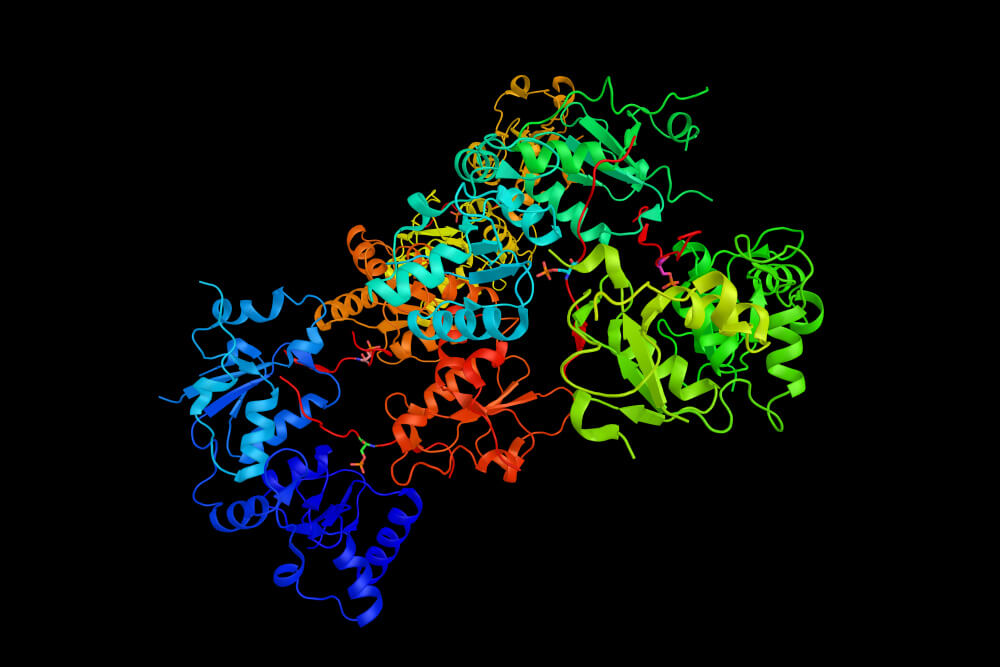In 2016, the key to naturally deconstructing plastic seemed to have been found. News had broken about plastic-eating bacteria discovered in Japan. The bacterium contains a protein that can break down plastic, a pollutant that is linked to health issues including cancer.
Since then, protein engineers have been trying to give that protein superpowers not needed in nature, but essential for industrial recycling. That effort has been slow, but a new tool from the Dana-Farber Cancer Institute lab of Nicholas Gauthier, PhD, could help pick up the pace.
Gauthier and Benjamin Fram, PhD, have created a new method that can take an existing protein, along with its evolutionary history, and propose a range of very different new designs that not only maintain the form and function of the original but also build on it with new features that would be unlikely in nature, such as the ability to tolerate high temperatures or interact with new molecules.
The ability to reliably take functional leaps without losing the original capability has been a long-sought goal of protein engineering in industry and in medicine. In cancer medicine, for instance, protein engineers could apply this tool to design protein degraders that eliminate proteins that drive cancer. The algorithm could also potentially be used to create vaccines or other biologic medicines that are stable and don’t need to be refrigerated.
The advance, which was published on June 20, 2024, in Nature Communications, is one of many that have recently vaulted protein engineering into a new realm of potential.
“It’s exciting to see how far the field has come. Protein engineering is gearing up to solve a lot of problems,” says Gauthier, who is collaborating with the National Renewable Energy Laboratory to engineer proteins to help solve the plastic problem. “It is a totally different way of solving programs in health, the environment, and industry.”

A quantitative approach
Proteins are complex 3D machines. The instructions used to build them are made of DNA, like “a string of colored beads,” says Gauthier. They aren’t something a human can understand and edit. To engineer a new protein, engineers must mutate the DNA, exchanging one or many beads for others, and then see what a bacterium’s protein building machinery makes of it.
“If you introduce more than a few mutations, you usually kill the function of the protein,” says Gauthier,
To increase the chances that mutated instructions would still produce a functional protein, the team tapped into an existing tool called evolutionary couplings, which assesses how related proteins have evolved over time. One of the first of these tools was designed by Dana-Farber researcher Chris Sander, PhD, and Debora Marks, PhD, at Harvard Medical School, both of whom are authors on this study.
Evolutionary couplings models look at all the known variants of a protein to determine which parts of the DNA sequence never change and which parts change together. The parts that never change are probably essential and shouldn’t change. The parts that change together probably code for parts of the protein that interact in the folds of the 3D machinery. If a new design were to change them, they should change together.
Using this information, the team designed an algorithm that scores potential new sequences based on a few key metrics. The sequence must be altered from the original, but not by more than 30% to preserve its essence. New designs also scored higher if they did not alter areas that have been preserved over time or if they altered segments together when they appeared to be evolutionarily paired.
“This method is a clever way of getting a lot of diversity with a very high hit rate,” says Gauthier. “That will enable protein engineers to explore a lot more new areas of protein activity faster and with a lower investment.”
Increasing the hit rate
Fram and Gauthier chose one well-researched protein, ß-lactamase, to experiment with. ß-lactamase helps the bacterium E. coli resist antibiotics. They were able to retrieve from protein databases thousands of variations of ß-lactamase to evaluate, giving the evolutionary couplings models a lot to learn from.
“It’s kind of like the AI story. If we didn’t have these massive datasets, we wouldn’t be able to do this,” says Gauthier. “This is an example of how all of this aggregated data and technology is coming together to make more functional protein engineering tools.”
Fram and colleagues used the algorithm to generate 14 new ß-lactamase DNA sequences that were different from any that had evolved naturally. One, for example, had 84 mutations in its DNA sequence compared to the most similar ß-lactamase DNA sequence.
Three of the fourteen designs did not produce functional proteins. The rest, however, preserved the protein’s function. Together with collaborator Amir Kahn, PhD, at Trinity College Dublin, they derived 3D structures of these designs and observed that they maintained the overall structure of the original protein. Unexpectedly, the engineered proteins also had new and exciting features, such as an increased ability to tolerate heat, enhanced activity interacting with other molecules, and an ability to interact with new molecules.
“We didn’t think it was going to work,” says Fram. “Evolution works iteratively, slowly introducing mutations over time. Rapid mutation is dangerous because things stop working. But this approach allowed us to accelerate the process and jump to unnatural but functional sequences.”
In addition to helping with the design of new proteins, Gauthier says that the results of this study also hint at the power of protein design tools to peer into the future. “It can be anticipatory,” he says. “It could, for example, anticipate variants of the COVID virus that might emerge.”
